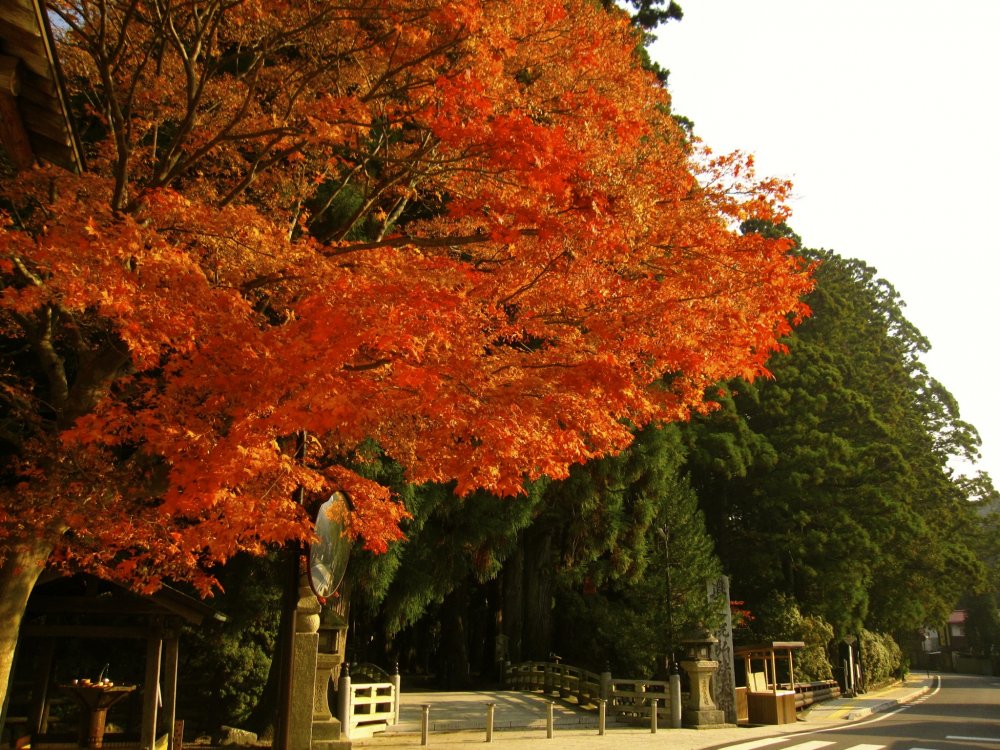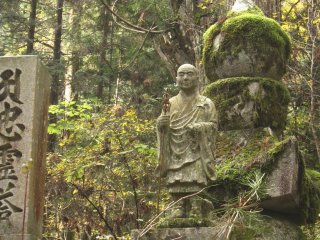
The entrance to Okunoin. The Ichinohashi Bridge (first bridge) is the traditional entrance to Okunoin, and those who enter bow and pay respect to Kobo Daishi (Kukai) before crossing it.

Kukai (posthumously named Kobo Daishi), the founder of Shingon Buddhism, is one of the most revered historical figures in Japan
!["Gorinto" is a five-story pagoda symbolizing the 5 elements of the universe in Buddhism: Earth, Water, Fire, Wind, and Space.]()
"Gorinto" is a five-story pagoda symbolizing the 5 elements of the universe in Buddhism: Earth, Water, Fire, Wind, and Space.
!["gorintos" or five-story pagodas abound at Okunoin]()
"gorintos" or five-story pagodas abound at Okunoin
![The path goes through various moss-covered tombstones and big, ancient cypresses and cedar trees.]()
The path goes through various moss-covered tombstones and big, ancient cypresses and cedar trees.
![three statues each holding a golden disc with fetus engraved inside]()
three statues each holding a golden disc with fetus engraved inside
![small Jizo bosatsu statues are often wrapped with a red or white bib, the Japanese believe they protect children, pregnant women and travelers]()
small Jizo bosatsu statues are often wrapped with a red or white bib, the Japanese believe they protect children, pregnant women and travelers
![clear water signifies a clear heart]()
clear water signifies a clear heart
!["gorintos" or five-story pagodas of varying heights]()
"gorintos" or five-story pagodas of varying heights
![The heart shape of this window could be akin to the shape of a peach or lotus petals, which are frequently used in Buddhist symbology. The carving behind reminds me of a small obelisk jutting out of a flowering lotus.]()
The heart shape of this window could be akin to the shape of a peach or lotus petals, which are frequently used in Buddhist symbology. The carving behind reminds me of a small obelisk jutting out of a flowering lotus.
![a nice painting of a loved one]()
a nice painting of a loved one
![A small altar with multi-colored cranes. According to an ancient Japanese legend, anyone who folds a thousand origami cranes will be granted a wish by a crane. Cranes also symbolize hope and joy.]()
A small altar with multi-colored cranes. According to an ancient Japanese legend, anyone who folds a thousand origami cranes will be granted a wish by a crane. Cranes also symbolize hope and joy.
![It is said that if you could not see your reflection in this well, you would die within 3 years. I'm so glad I saw mine! ;)]()
It is said that if you could not see your reflection in this well, you would die within 3 years. I'm so glad I saw mine! ;)
![the infinity symbol with prayer beads on top]()
the infinity symbol with prayer beads on top
![just before reaching Kukai's (aka Kobo Daishi) mausoleum at the main hall, pilgrims wash their hands, say wishes, and splash water on the Buddhist statues (Photography is forbidden soon beyond this point.)]()
just before reaching Kukai's (aka Kobo Daishi) mausoleum at the main hall, pilgrims wash their hands, say wishes, and splash water on the Buddhist statues (Photography is forbidden soon beyond this point.)
![Some plots at Okunoin are reserved for families or corporate employees.]()
Some plots at Okunoin are reserved for families or corporate employees.
![beautiful autumn tree at Okunoin]()
beautiful autumn tree at Okunoin
![Momiji at Okunoin]()
Momiji at Okunoin
![In ancient times, it was believed that children who died could not go to heaven because they had caused great sorrow to their parents. Grieving parents would pray to Jizo and ask that their children be guided to heaven. They would wrap articles of their children’s clothing around Jizo statues.Thus, the tradition of wrapping a red bib around Jizo bosatsu statues evolved when asking for favors for children. ]()
In ancient times, it was believed that children who died could not go to heaven because they had caused great sorrow to their parents. Grieving parents would pray to Jizo and ask that their children be guided to heaven. They would wrap articles of their children’s clothing around Jizo statues.Thus, the tradition of wrapping a red bib around Jizo bosatsu statues evolved when asking for favors for children.
![a modern version of a Jizo statue, also respectfully called Ojizosan]()
a modern version of a Jizo statue, also respectfully called Ojizosan
![modern-day pilgrims wearing traditional garb ]()
modern-day pilgrims wearing traditional garb
![traditional Japanese red bridge]()
traditional Japanese red bridge
![fallen gingko leaves]()
fallen gingko leaves
![a monk and a pilgrim]()
a monk and a pilgrim
![a low gate covered with moss]()
a low gate covered with moss
![In Japan, rocks such as this one here have a spiritual significance. There is a smooth boulder housed inside a small wooden building there called the Miroku stone (not the one pictured here). One is challenged to lift it to a shelf. It is believed that the stone feels lighter to good people and heavier to bad people.]()
In Japan, rocks such as this one here have a spiritual significance. There is a smooth boulder housed inside a small wooden building there called the Miroku stone (not the one pictured here). One is challenged to lift it to a shelf. It is believed that the stone feels lighter to good people and heavier to bad people.
![Kukai's statues are seen at various spots inside Okunoin]()
Kukai's statues are seen at various spots inside Okunoin
![a statue of Kannon-sama, Goddess of Compassion]()
a statue of Kannon-sama, Goddess of Compassion
![mother-and-child statue]()
mother-and-child statue
![statues, ancient trees, stone markers and tombstones abound inside Okunoin]()
statues, ancient trees, stone markers and tombstones abound inside Okunoin
![Going through another quieter route to get out of Okunoin, I chanced upon one of the autumn beauties in the Japanese countryside - a field of "susuki" (Japanese pampas grass).]()
Going through another quieter route to get out of Okunoin, I chanced upon one of the autumn beauties in the Japanese countryside - a field of "susuki" (Japanese pampas grass).
![A burst of red greeted me before I left the huge grounds of Okunoin.]()
A burst of red greeted me before I left the huge grounds of Okunoin.
![A beautiful back figure of Kannon-sama, the Goddess of Compassion, greeted me as I ushered myself out into the light after a solemn walk inside Japan's largest graveyard.]()
A beautiful back figure of Kannon-sama, the Goddess of Compassion, greeted me as I ushered myself out into the light after a solemn walk inside Japan's largest graveyard.
![May all beings be happy!]()
May all beings be happy!


























































































